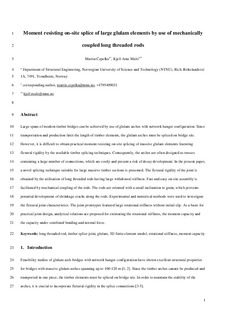| dc.contributor.author | Cepelka, Martin | |
| dc.contributor.author | Malo, Kjell Arne | |
| dc.date.accessioned | 2018-04-04T07:42:03Z | |
| dc.date.available | 2018-04-04T07:42:03Z | |
| dc.date.created | 2018-03-27T12:55:27Z | |
| dc.date.issued | 2018 | |
| dc.identifier.citation | Engineering structures. 2018, 163 347-357. | nb_NO |
| dc.identifier.issn | 0141-0296 | |
| dc.identifier.uri | http://hdl.handle.net/11250/2492485 | |
| dc.description.abstract | Large spans of modern timber bridges can be achieved by use of glulam arches with network hanger configuration. Since transportation and production limit the length of timber elements, the glulam arches must be spliced on bridge site. However, it is difficult to obtain practical moment resisting on-site splicing of massive glulam elements featuring flexural rigidity by the available timber splicing techniques. Consequently, the arches are often designed as trusses containing a large number of connections, which are costly and present a risk of decay development. In the present paper, a novel splicing technique suitable for large massive timber sections is presented. The flexural rigidity of the joint is obtained by the utilisation of long threaded rods having large withdrawal stiffness. Fast and easy on-site assembly is facilitated by mechanical coupling of the rods. The rods are oriented with a small inclination to grain, which prevents potential development of shrinkage cracks along the rods. Experimental and numerical methods were used to investigate the flexural joint characteristics. The joint prototypes featured large rotational stiffness without initial slip. As a basis for practical joint design, analytical relations are proposed for estimating the rotational stiffness, the moment capacity and the capacity under combined bending and normal force. | nb_NO |
| dc.language.iso | eng | nb_NO |
| dc.publisher | Elsevier | nb_NO |
| dc.rights | Attribution-NonCommercial-NoDerivatives 4.0 Internasjonal | * |
| dc.rights.uri | http://creativecommons.org/licenses/by-nc-nd/4.0/deed.no | * |
| dc.title | Moment resisting on-site splice of large glulam elements by use of mechanically coupled long threaded rods | nb_NO |
| dc.type | Journal article | nb_NO |
| dc.type | Peer reviewed | nb_NO |
| dc.description.version | acceptedVersion | nb_NO |
| dc.source.pagenumber | 347-357 | nb_NO |
| dc.source.volume | 163 | nb_NO |
| dc.source.journal | Engineering structures | nb_NO |
| dc.identifier.doi | https://doi.org/10.1016/j.engstruct.2018.02.071 | |
| dc.identifier.cristin | 1575917 | |
| dc.description.localcode | © 2018. This is the authors’ accepted and refereed manuscript to the article. Locked until 19-3-2020 due to copyright restrictions. This manuscript version is made available under the CC-BY-NC-ND 4.0 license http://creativecommons.org/licenses/by-nc-nd/4.0/ | nb_NO |
| cristin.unitcode | 194,64,45,0 | |
| cristin.unitname | Institutt for konstruksjonsteknikk | |
| cristin.ispublished | true | |
| cristin.fulltext | postprint | |
| cristin.qualitycode | 2 | |

